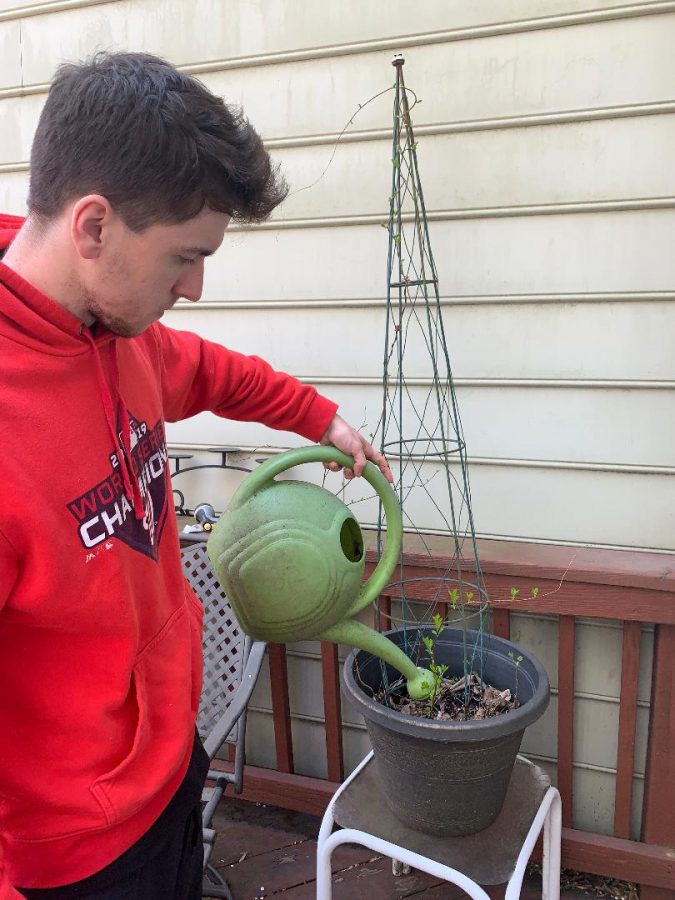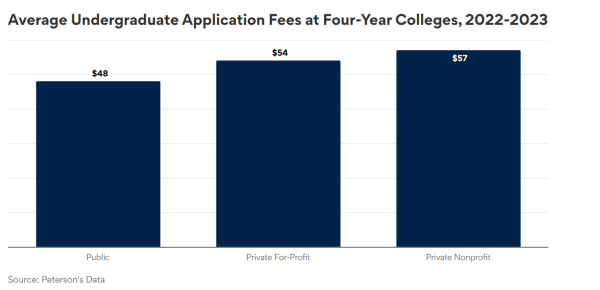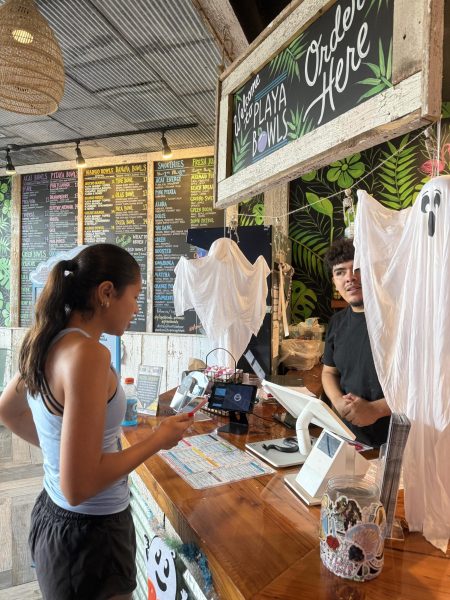Move toward healthier eating: Grow your own food
Senior Jonathan Healy waters his cucumber plants after just planting them on Apr. 7.
As eating healthier is becoming a larger movement and trend, debates arise over what is the best way to eat healthier. The most organic, natural way of consuming the most important parts of our diets, fruits, and vegetables, is to grow them on your own.
The process of growing fruits and vegetables can be intimidating, however, when done correctly, the process is rather simple.
- Choose where you want to plant
This will determine how much of the materials you will need. This includes the amount of soil as well as how many plants you need to buy. A raised bed is common and works well. You can also build a soil bed in an area that gets a lot of sunlight.
- Choose the right soil
The best soil for fruits and vegetables is a compost mixture. Lobster compost is a common soil that can be found at Home Depot, Whole Foods, and local garden centers. BumperCrop™ is an organic soil composed of “shellfish compost, darl, rich earthworm castings (adds minerals and biology), kelp, peat, aged bark, and lobster,” according to Master Nursery.
Senior Laura See shops at a local garden center called Good Earth. “My family shops at Good Earth and we get a soil conditioner called BumperCrop™ from them each year as we build our vegetable garden. You mix this soil 50/50 in with the existing soil” senior Laura See said.
BumperCrop™ is a soil conditioner that you mix 50/50 with the existing soil in the ground. A raised bed mix is another possibility if planting in a raised bed. The amount of soil that you need depends on how many plants you are planting as well as how big the area is.
- Choose what you want to plant
Now that it is April, it is almost time to plant warm-weather fruits and vegetables. These include eggplant, cucumber, peppers, tomatoes and spinach. Fruits include watermelon, strawberry and avocado. There is not one that is easier than the others, so choose what you enjoy eating. Nursery growers start seeds in pots and these can be bought at grocery stores, certain hardware stores and local garden centers. “I wanted to start with just strawberries because it seemed simple and I made sure the plant got the right conditions and by the start of summer I had a bunch of strawberries for my family and I to enjoy,” senior Jonathan Healy said.
- Mix a root stimulator into the soil
When plants are taken out of their original pot and exposed to new soil, they risk experiencing transplant shock. The best way to prevent this is using a root stimulator. These can also be found at local places or ordered on Amazon. The best one, in my opinion, is Espoma BioTone. You sprinkle a light layer over the soil before you transplant the plants. I work at the local garden center See mentioned, Good Earth. I have planted many plants myself and witnessed others attempt to plant.
- Take the vegetables out of the pot and break up the roots
Finally, time to plant. If you buy the plants in grower’s pots, they are most likely root bound and will easily come out of their pots. Once out of the pot, break up the roots at the bottom and put it in the soil. Pack the extra soil from the hole and make the plant snug in its new spot.
- Water the plants
Once planted, the plants need water right away and lots of sunlight. The amount of water depends on the plant.
- Protect from deer
Deer love fruits and vegetables. If deer can get to the area, it is important to take steps to prevent them from eating your crops. Two ways to do so are to use a deer repellent spray or granular product on and around the area of the plants. You want to make sure these products are organic and safe to consume once the fruits and vegetables are harvested. Another way is to use stakes, wire and deer netting over the plants.
Your donation will support the student journalists of Thomas S. Wootton High School. Your contribution will allow us to purchase equipment and cover our annual website hosting costs.
Maya Erd is a 2021 graduate.







![Editors-in-Chief Ahmed Ibrahim, Helen Manolis, Cameron Cowen, Alex Grainger, Emory Scofield, Hayley Gottesman, Rebekah Buchman and Marley Hoffman create the first print magazine of the year during the October press days. “Only a quarter of the schools in MCPS have programs that are like ours, a thriving, robust program. That makes me really sad. This is not just good for [the student journalists] to be doing this, it’s good for the entire community. What [student journalists] provide to the community is a faith in journalism and that continues for their lifetimes," Starr said.](https://woottoncommonsense.com/wp-content/uploads/2025/10/wmpoFTZkCPiVA3YXA4tnGoSsZ4KmnKYBIfr18p3l-450x600.jpg)